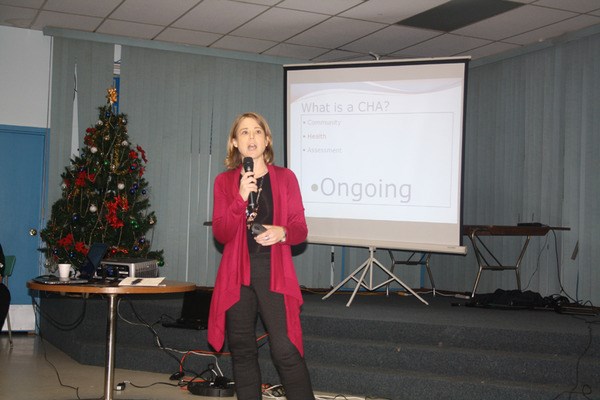The Burntwood Regional Health Authority (BRHA) has rolled out the 2010 Community Health Assessment (CHA), a 700-page document which is available in its entirety on the BRHA website.
The CHA was also the keynote subject at the BRHA's annual general meeting Nov. 24, during which BRHA epidemiologist Cynthia Carr, who was instrumental in putting the report together, shared some of its highlights with those in attendance.
"The most important thing about this is that this is ongoing," said Carr. "Yes, we're required to do this big community health assessment every five years, but we don't want to just write this document, put it on the shelf, and keep going on. We want to look at what were some priorities, where we can do additional research or program planning."
Carr said that the goal of the CHA is "to give a picture about the region, and to answer some questions about how healthy we are, what makes us sick, what other factors determine our health, and what services are we using." This picture in turn allows for the BRHA to be better informed when it looks at strategic planning.
"It's really important to think of health as a holistically complete state of physical, mental, emotional and spiritual well-being, not just the absence of illness," explained Carr. "It's not just about sickness and going to the hospital. There's so much research that shows the link between choices we make in lifestyle, physical activity, our education levels, our income - all of these things impact health."
To prepare for this assessment, the BRHA consulted with community members from across its region. "We had over 250 community members at these consultation sessions, and we really appreciated the input we received," said Carr. "There were some common things that really came out loud and clear. One was concern about health of families, of children, of lifestyle choices, of risky behaviour. Those things we heard over and over again."
"We also heard some really good things about satisfaction with services, and the acknowledgment that when you live in a small community, we can't have all of the services that you would have in a larger community even though that can make things a little more challenging," she continued. "People told us that they were very pleased with programs such as the Family First home visitor program that comes and provides support with mom in her own home. Patient satisfaction surveys that were reviewed show us that overall, patients were quite satisfied with our services. We're seeing some increases in some key diagnostic procedures within the region, and also getting more people into Winnipeg to have those procedures."
However, it wasn't all good news in the CHA. Some of the reasons for this could be demographic - "we have a very young population compared to the rest of Manitoba, and with that comes high birth rates," said Carr, adding that projections show the highest population increase over the next few years will be in the age range of 65 years and older.
Some of the problems might also stem from socioeconomic factors - Carr said that the CHA found that just over half of all Burntwood residents do not have a high school diploma, compared to a provincial average of 29 per cent. Unemployment is also a concern, sitting at 17.4 per cent, more than three times the provincial rate.
"We continue to have the highest smoking rates in the province," said Carr. "Almost three-quarters of [adult] residents meet the criteria for being overweight or obese. Almost half of residents of the region are inactive."
Other figures show that 13 per cent of Burntwood adults have been treated for substance abuse issues - compared to 5 per cent in Manitoba overall - and 23 per cent of mothers have reported alcohol use during pregnancy. Sticking with pregnancy, the Burntwood region has the highest teen pregnancy rate in among Manitoba RHAs. Diabetes rates are also high, with at least one in five adults living with that disease.
"We're a young region, we should be healthy," said Carr. "We shouldn't be seeing higher rates of chronic diseases than what we're seeing in Manitoba with older people."
Overall, though, the message in Carr's presentation was one of positivity. "The blue light initiative, where households that committed to not smoking received a blue light to put on their front porch, was mentioned with pride by community members," said Carr, also noting that the BRHA had received good marks for offering culturally appropriate services. "What I heard over and over again when I went into the communities was praise for the regional health authority for being really involved in front-line community initiatives, coming out to the communities for meetings and events."




